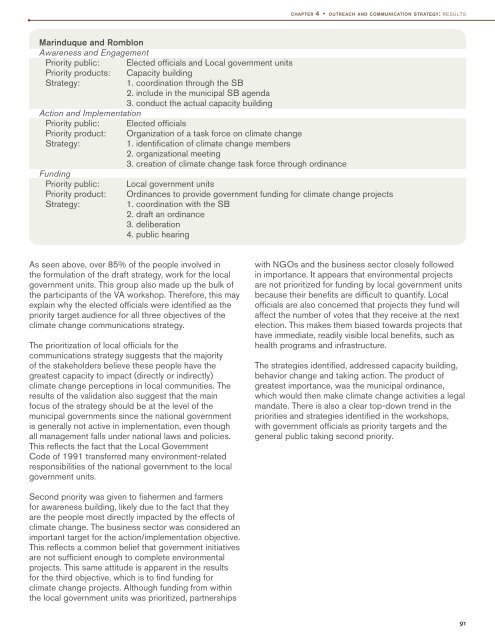of the Verde Island Passage, Philippines - weADAPT
of the Verde Island Passage, Philippines - weADAPT
of the Verde Island Passage, Philippines - weADAPT
You also want an ePaper? Increase the reach of your titles
YUMPU automatically turns print PDFs into web optimized ePapers that Google loves.
chapter 4 • outreach and communication strategy: results<br />
Marinduque and Romblon<br />
Awareness and Engagement<br />
Priority public: Elected <strong>of</strong>ficials and Local government units<br />
Priority products: Capacity building<br />
Strategy:<br />
1. coordination through <strong>the</strong> SB<br />
2. include in <strong>the</strong> municipal SB agenda<br />
3. conduct <strong>the</strong> actual capacity building<br />
Action and Implementation<br />
Priority public: Elected <strong>of</strong>ficials<br />
Priority product: Organization <strong>of</strong> a task force on climate change<br />
Strategy:<br />
1. identification <strong>of</strong> climate change members<br />
2. organizational meeting<br />
3. creation <strong>of</strong> climate change task force through ordinance<br />
Funding<br />
Priority public: Local government units<br />
Priority product: Ordinances to provide government funding for climate change projects<br />
Strategy:<br />
1. coordination with <strong>the</strong> SB<br />
2. draft an ordinance<br />
3. deliberation<br />
4. public hearing<br />
As seen above, over 85% <strong>of</strong> <strong>the</strong> people involved in<br />
<strong>the</strong> formulation <strong>of</strong> <strong>the</strong> draft strategy, work for <strong>the</strong> local<br />
government units. This group also made up <strong>the</strong> bulk <strong>of</strong><br />
<strong>the</strong> participants <strong>of</strong> <strong>the</strong> VA workshop. Therefore, this may<br />
explain why <strong>the</strong> elected <strong>of</strong>ficials were identified as <strong>the</strong><br />
priority target audience for all three objectives <strong>of</strong> <strong>the</strong><br />
climate change communications strategy.<br />
The prioritization <strong>of</strong> local <strong>of</strong>ficials for <strong>the</strong><br />
communications strategy suggests that <strong>the</strong> majority<br />
<strong>of</strong> <strong>the</strong> stakeholders believe <strong>the</strong>se people have <strong>the</strong><br />
greatest capacity to impact (directly or indirectly)<br />
climate change perceptions in local communities. The<br />
results <strong>of</strong> <strong>the</strong> validation also suggest that <strong>the</strong> main<br />
focus <strong>of</strong> <strong>the</strong> strategy should be at <strong>the</strong> level <strong>of</strong> <strong>the</strong><br />
municipal governments since <strong>the</strong> national government<br />
is generally not active in implementation, even though<br />
all management falls under national laws and policies.<br />
This reflects <strong>the</strong> fact that <strong>the</strong> Local Government<br />
Code <strong>of</strong> 1991 transferred many environment-related<br />
responsibilities <strong>of</strong> <strong>the</strong> national government to <strong>the</strong> local<br />
government units.<br />
with NGOs and <strong>the</strong> business sector closely followed<br />
in importance. It appears that environmental projects<br />
are not prioritized for funding by local government units<br />
because <strong>the</strong>ir benefits are difficult to quantify. Local<br />
<strong>of</strong>ficials are also concerned that projects <strong>the</strong>y fund will<br />
affect <strong>the</strong> number <strong>of</strong> votes that <strong>the</strong>y receive at <strong>the</strong> next<br />
election. This makes <strong>the</strong>m biased towards projects that<br />
have immediate, readily visible local benefits, such as<br />
health programs and infrastructure.<br />
The strategies identified, addressed capacity building,<br />
behavior change and taking action. The product <strong>of</strong><br />
greatest importance, was <strong>the</strong> municipal ordinance,<br />
which would <strong>the</strong>n make climate change activities a legal<br />
mandate. There is also a clear top-down trend in <strong>the</strong><br />
priorities and strategies identified in <strong>the</strong> workshops,<br />
with government <strong>of</strong>ficials as priority targets and <strong>the</strong><br />
general public taking second priority.<br />
Second priority was given to fishermen and farmers<br />
for awareness building, likely due to <strong>the</strong> fact that <strong>the</strong>y<br />
are <strong>the</strong> people most directly impacted by <strong>the</strong> effects <strong>of</strong><br />
climate change. The business sector was considered an<br />
important target for <strong>the</strong> action/implementation objective.<br />
This reflects a common belief that government initiatives<br />
are not sufficient enough to complete environmental<br />
projects. This same attitude is apparent in <strong>the</strong> results<br />
for <strong>the</strong> third objective, which is to find funding for<br />
climate change projects. Although funding from within<br />
<strong>the</strong> local government units was prioritized, partnerships<br />
91
















